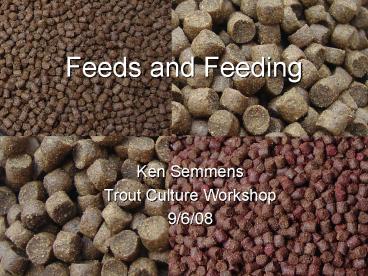Feeds and Feeding - PowerPoint PPT Presentation
1 / 33
Title: Feeds and Feeding
1
Feeds and Feeding
Ken Semmens Trout Culture Workshop 9/6/08
2
Convert feed into fish flesh
3
Feed Decisions - Procurement
- What company
- Melick
- Zeigler Silver, Gold, Platinum
- Silver Cup Steelhead, Salmon,
- Burris
- What formula Extruded Feeds
- Protein
- Fat
- What Pellet Size
- How much feed/shipment.
4
Recent Cost
- Melick 42/16 is 0.546/lb delivered by Don
Anderson. - Silver Cup 45/16 .51/lb delivery
- Silver Cup 44/20 .53/lb delivery
- Silver Cup 44/25 .56/lb delivery
- Zeigler 42/16 (Gold)
- Slow sink 0.505/lb delivery
- Floating 0.5323/lb delivery
5
From an old Zeigler Brochure
6
Principle
- Protein content of the feed decreases as the fish
get larger (Source Fish Hatchery Management 2nd
ed.)
7
Changes in protein and fat levels in trout feeds
8
www.silvercup.com/feedsize.htm
9
Buying and Storing Feed
- Dry
- Cool
- Protected from rodents.
- On pallets
- Order what you will need for a couple of months.
- Consider pooling purchases with a neighbor to
minimize transportation costs.
10
Feed Decisions - Distribution
- Storage
- Amount to Feed
- Satiation
- Schedule
- Feeding frequency.
- Feeding method
- Hand
- Demand Feeders
- Belt Feeders
11
Feeding by Hand
12
Demand Feeder
13
Tools of the Trade
Demand Feeder
14
(No Transcript)
15
Some Principles - System
- Amount which can be fed/day depends on how much
oxygen is available. - Cannot make up for days not fed.
- Potential production directly related to the
amount of feed fed.
16
Which is the best deal ?
- Need to know
- How well the feed works (Efficiency)
- Cost of the feed
- Delivery Cost
- Estimate Cost/lb of gain.
17
Cost/lb of gain
18
Efficiency
- Feed Efficiency
- Amount gained/ Amount fed.
- Practical Feed Conversion
- Amount fed/ Amount gained
- Influence of mortality
19
Maximum Efficiency
- Highest weight gain and maximum feed efficiency
are mutually exclusive. - Trout fed about 75 of satiation will convert
feed most efficiently.
20
Schematic relationship between feed intake, fish
growth rate, and feed conversion ratio (FCR) .
(from Barrows and Hardy 2001)
Growth rate (percent gain/day)
Feed Conversion Ratio (g feed/g gain)
Feeding level (percent dry fish weight/day)
21
Some Principles - Fish
- Trout will eat a certain number of calories each
day. - Amount of feed needed decreases with increased
protein and fat. - Small fish convert feed more efficiently than
large fish. - 1 lb of small fish will eat more than 1 lb of
large fish. (Body Weight)
22
(No Transcript)
23
(No Transcript)
24
Theoretical Feed Conversion
- Based on energy content of the feed.
- Trout need about 1700 Calories to gain 1 lb.
- Analysis of the feed (protein, fat and
carbohydrate). - Zeigler Gold 1817 calories/lb
- Silver Cup 44/20 1928 calories/lb
- Melick 42/16 1833 calories/lb
25
Comparing Feed Costs
26
Feeding Errors
- Wrong Feed
- Feeding too little
- Do not realize growth potential
- Takes longer to reach market size
- More size variation
- Feeding too much
- Wasted feed
- Dirty, higher risk from disease
- Less efficient.
- Presentation
27
Feeding Plan
28
Amount to feed
- Example worksheet (alt tab)
29
Feeding Just Right
- Realize growth potential
- Able to predict fish size and number.
- Good efficiency
- No wasted feed
- Improve survival
- Minimize size variation.
- Minimize Cost/lb of gain
- Profit.
30
(No Transcript)
31
(No Transcript)
32
(No Transcript)
33
(No Transcript)

